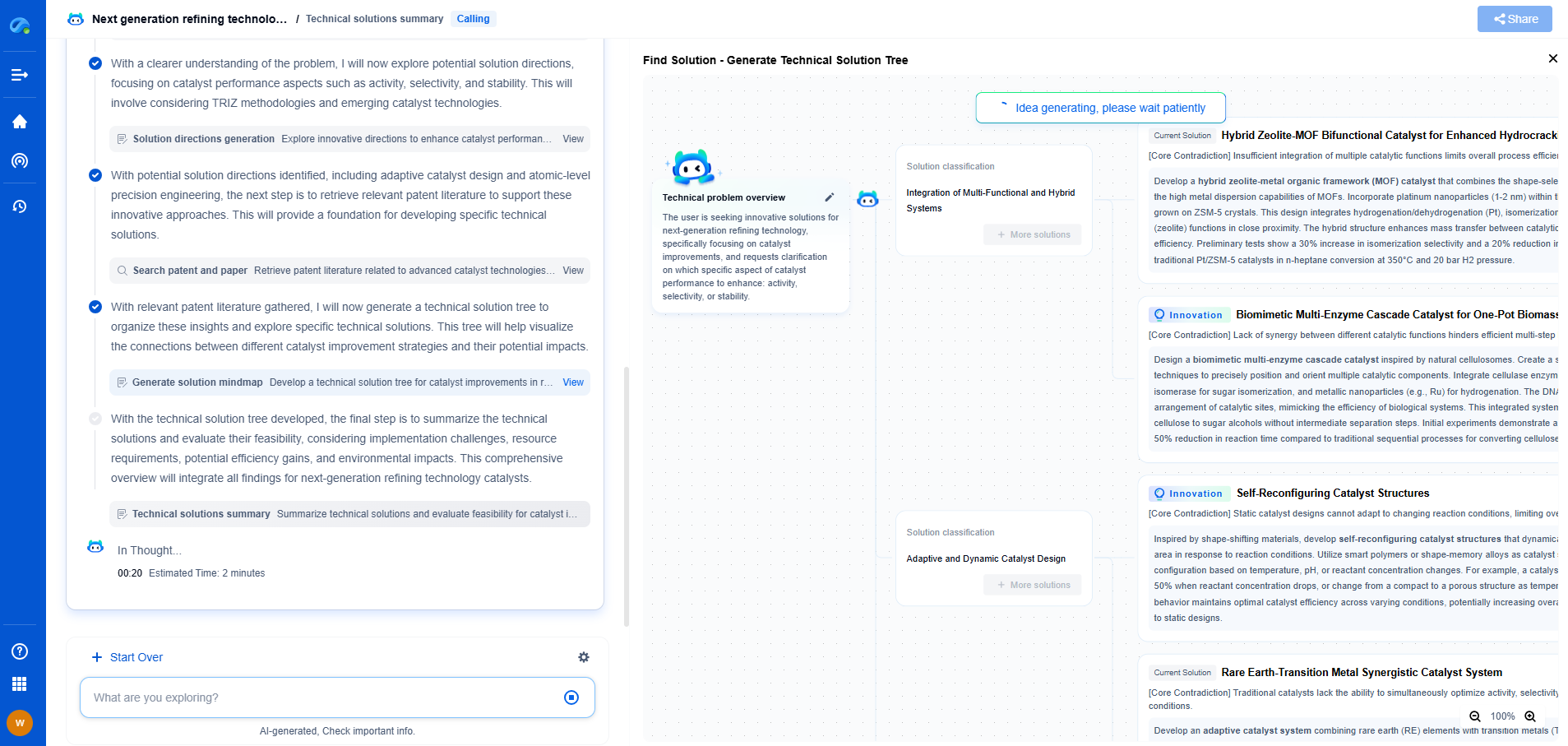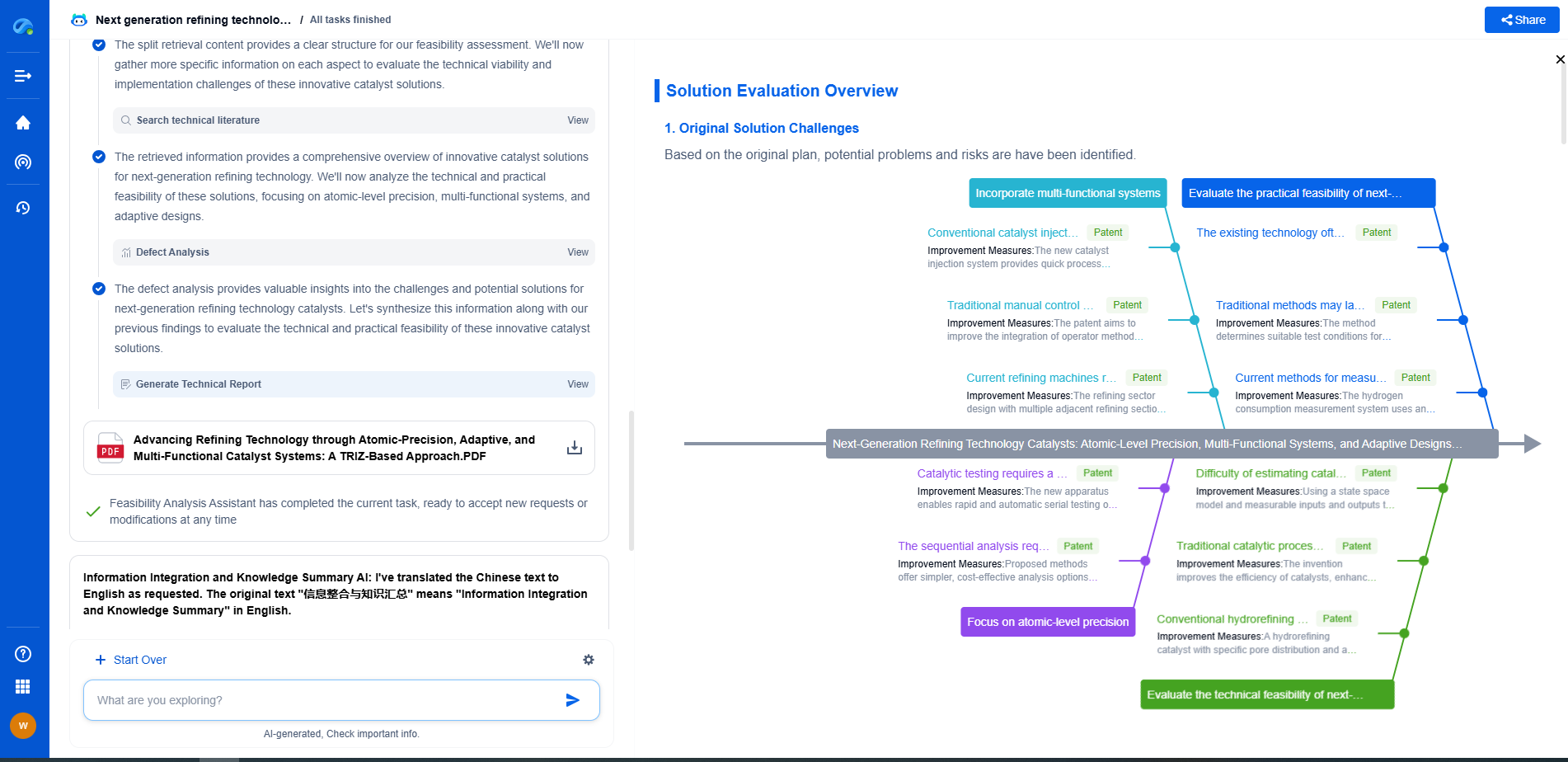Choosing the Right Catalyst System for Coordination Polymerization
JUL 3, 2025 |
Coordination polymerization plays a pivotal role in the production of various polymers, including polyethylene, polypropylene, and other specialty polymers. This process involves the polymerization of olefins and other monomers through the formation of a complex between the monomer and a metal catalyst. Choosing the right catalyst system is crucial for controlling the polymerization process, influencing the molecular weight, stereoregularity, and overall properties of the resulting polymer. This article explores the key considerations when selecting a catalyst system for coordination polymerization.
Understanding Catalyst Systems
A catalyst system for coordination polymerization typically consists of a transition metal compound (such as titanium, zirconium, or nickel) and a co-catalyst or activator (often an organoaluminum compound). These systems can be broadly classified into Ziegler-Natta catalysts, metallocene catalysts, and post-metallocene catalysts.
Ziegler-Natta Catalysts
Ziegler-Natta catalysts are the most widely used in industry for the polymerization of alpha-olefins. These catalysts offer excellent control over the tacticity of polymers, making them ideal for producing isotactic and syndiotactic polymers. However, they often require complex synthesis and are sensitive to impurities, which may necessitate rigorous purification of monomers and solvents.
Metallocene Catalysts
Metallocene catalysts, recognized by their distinct cyclopentadienyl (Cp) ligands, provide a different level of control over polymer architecture. They allow for precise regulation of molecular weight distribution and enable the synthesis of unique polymers with tailored properties. Metallocenes are particularly suitable for producing linear low-density polyethylene (LLDPE) and elastomers. However, the high cost of these catalysts and their susceptibility to deactivation by polar groups in the monomers can limit their applicability.
Post-Metallocene Catalysts
Post-metallocene catalysts represent the latest evolution in coordination polymerization technology. They offer enhanced stability and efficiency, overcoming some of the limitations of metallocenes. These catalysts can tolerate a wider range of functional groups, enabling the polymerization of monomers that were previously challenging. Their versatility paves the way for the development of new polymers with advanced functionalities.
Factors to Consider When Choosing a Catalyst System
Monomer Type and Purity
The type of monomer you intend to polymerize significantly influences the choice of catalyst. For example, Ziegler-Natta systems are well-suited for non-polar monomers, while metallocene and post-metallocene systems excel with polar and bulky monomers. Additionally, the purity of the monomer is crucial, as impurities can poison the catalyst and hinder the polymerization process.
Desired Polymer Properties
The desired properties of the final polymer also dictate the selection of the catalyst system. If high stereoregularity is crucial, a Ziegler-Natta catalyst might be preferred. For tailored molecular weight distribution, metallocenes are often the go-to choice. Assessing the end-use application of the polymer helps determine the necessary properties and, consequently, the appropriate catalyst.
Operational Conditions
The operational conditions, such as temperature, pressure, and solvent, can impact the performance of the catalyst system. Some catalysts may require specific conditions to achieve optimal activity and selectivity. Understanding these requirements is vital for ensuring efficient polymerization and achieving desired polymer characteristics.
Economic Considerations
Economic factors, including catalyst cost and process efficiency, are also important. Ziegler-Natta catalysts are generally more cost-effective, making them suitable for large-scale applications. However, the potential for unique and high-value polymers may justify the higher costs associated with metallocene or post-metallocene systems in certain cases.
Future Trends in Catalyst Systems
Research and development in catalyst systems for coordination polymerization continue to advance, driven by the demand for more sustainable and efficient processes. Innovations focus on enhancing catalyst stability, expanding the range of polymerizable monomers, and reducing environmental impact. The integration of computational modeling and machine learning to design and optimize catalyst systems is also an emerging trend, promising faster and more cost-effective development of new materials.
Conclusion
Choosing the right catalyst system for coordination polymerization is a complex decision that involves balancing various factors, including monomer characteristics, desired polymer properties, operational conditions, and economic considerations. As the field evolves, new catalyst systems continue to emerge, offering improved performance and sustainability. By carefully assessing these factors and staying informed about the latest developments, scientists and engineers can effectively tailor catalyst systems to meet the demands of modern polymer applications.
Transform Polymeric Innovation with Patsnap Eureka
From biodegradable polymers to high-performance composites, the world of polymeric compounds is evolving faster than ever—driven by the demands of sustainability, functional customization, and global IP competition. Whether you're exploring novel copolymer architectures, optimizing polymerization techniques, or tracking material patents in bioplastics, time-to-insight is everything.
Patsnap Eureka, our intelligent AI assistant built for R&D professionals in high-tech sectors, empowers you with real-time expert-level analysis, technology roadmap exploration, and strategic mapping of core patents—all within a seamless, user-friendly interface.
Whether you're working on next-gen packaging films, bio-based resins, smart polymers for electronics, or new thermal-resistant composites, Eureka accelerates your journey from idea to patent to product—with unmatched clarity and speed.
🔍 Experience how Eureka can power your polymer R&D with AI intelligence—start your free trial today and unlock the future of materials innovation.
- R&D
- Intellectual Property
- Life Sciences
- Materials
- Tech Scout
- Unparalleled Data Quality
- Higher Quality Content
- 60% Fewer Hallucinations
Browse by: Latest US Patents, China's latest patents, Technical Efficacy Thesaurus, Application Domain, Technology Topic, Popular Technical Reports.
© 2025 PatSnap. All rights reserved.Legal|Privacy policy|Modern Slavery Act Transparency Statement|Sitemap|About US| Contact US: help@patsnap.com

